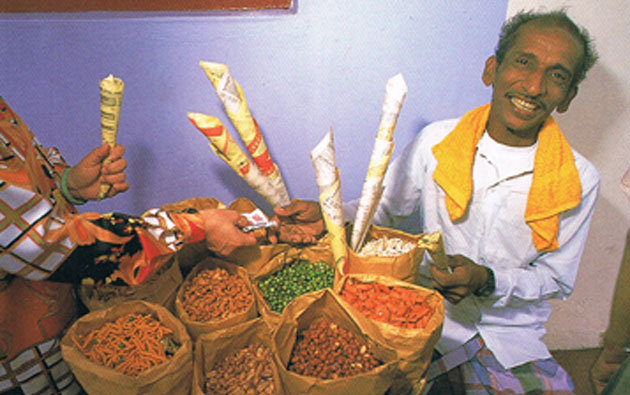
A tough nut to crack? (Going nuts investigating Kachang Puteh)
By Sheere Ng - Friday, Sep 23, 2011
Digging out information about Kachang Puteh was as difficult as finding one on the Singapore streets. Anecdotes from books were few and far between while the internet generated little useful results. The Little India Shop and Heritage Association (LISHA), sadly, had nothing more to offer than what I already knew – Kachang Puteh means white beans in Malay but actually comprises of many different types of nuts. It was sold mainly by the Indians, who usually peddled outside the cinemas. They would dress in white sarongs and balance a wooden rack that is filled with the Indian savouries on the top of their heads. Its cone shape packaging, made of newspapers and old exercise books, was most iconic of its street hawking days.

But wasn’t that common knowledge in which anyone with a computer and a broadband connection can find out? What about its origin, methods of preparation and selling point?
It came to me that the best snippets of food history come from people on the ground. Ramanan Subramaniam, who served Kachang Puteh at the Singapore Day in 2009, was one such man. “Kachang Puteh came from India. It’s called Chevdo,” he told me over the phone. “There, the Kachang Puteh man goes around in a pushcart with an attached wok, and roasts the nuts on the spot.”
But in Singapore, he said, the Kachang Puteh man prepared the nuts at home, and cooked them by three different methods – steam, fry with oil and dry fry. The more hardworking ones would also fry the groundnuts with hot sand, like how the Chinese street hawkers cooked the chestnuts with coffee grounds. “That was the best,” he reminisced.
Kachang Puteh sellers, however, did not always cook their own nuts. Dick Yip, who writes everything about Singapore on his blog The Wise Old Owl, replied in his email: “Kachang Puteh sellers also bought from other people who prepared in larger quantities. Eventually, some of these suppliers opened small factories or shophouses to cater to such demands.”
It is not difficult to understand why some of them had given up preparing the nuts themselves. Ramanan said it took him a back-breaking eight hours to fry just three types for the Singapore Day. Of course the quantity he prepared was huge given the scale of the event but one can imagine the hardwork required to prepare this humble snack.
Up till the 90s, Kachang Puteh was widely popular, even more so than today’s popcorns. One of the reasons was because it has a monopoly in the market. “Last time we didn’t have potato chips and chocolates,” Ramanan said. Kachang Puteh was a convenient snack for all occasions, from home parties to funerals. But most importantly, at about five cents per cone, it was dirt cheap.
Even though there are hardly any Kachang Puteh sellers these days, contrary to popular belief, the snack is not at the brink of death. “The nuts and beans are still available in even more varieties today than before. Supermarkets and shops sell all kinds of import from all over the world,” said Dick. So how can the sellers save themselves from endangerment? “With big companies offering the same, if not better things, it does not look likely that the Kachang Puteh man can re-invent himself to ensure he is not a relic of the past.”

In fact, the reinvention has already been made, but only those who had the foresight to do it while Kachang Puteh was still at its heyday were successful. Ong Tong Guan, the founder of Tong Garden, began by peddling peanuts on his bicycle, but he commercialised his business as early as 1963. Today, the brand has become a household name and its product can be found in many supermarkets.
Soon, Tong Garden and those alike will become the only source for Singaporeans to get their Kachang Puteh fix.
If you know anything about Kachang Puteh, write in to us. It is a heritage that we should not lose, and we deserve more than just popcorn.
During this Formula 1 season, Kachang Puteh will be made available at Makansutra Gluttons Bay.


